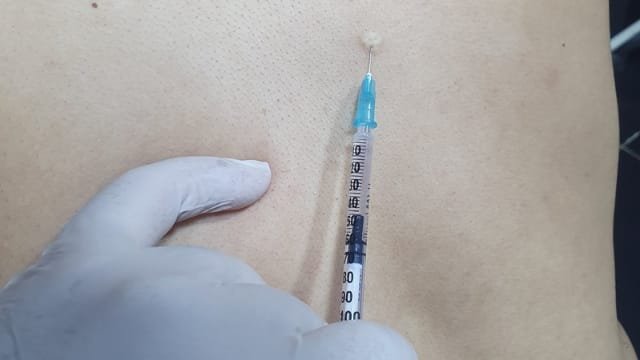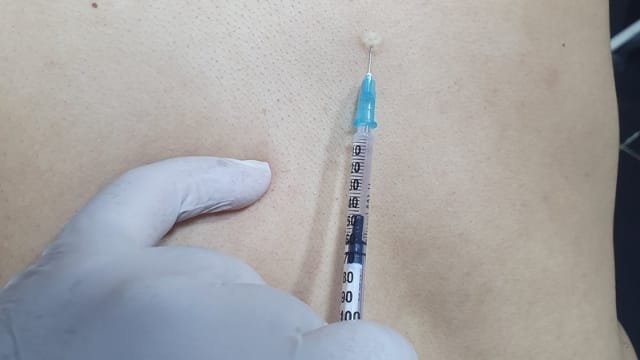دكتور أمجد هزاع

دكتور أمجد هزاع


يستخدم سم النحل والجهاز العصبي في مشكلات متعددة وعلى سبيل المثال في علاج التهاب الأعصاب الطرفية واضطرابات الجهاز العصبي الطرفي كما يستخدم في علاج بعض اضطرابات الجهاز العصبي المركزي وتختلف الاستجابة طبقا لمدى الاصابة وبصورة عامة فان سم النحل منشط للجهاز العصبي المركزي والطرفي CNS and PNS
تشيد الدراسات بتأثير سم النحل على الجهاز العصبي المركزي حيث أن سم النحل :
وتؤكد الابحاث دور سم النحل في امراض الجهاز العصبي المركزي والطرفي Diseases of the central and peripheral nervous system(CNS, (PNS) كما يعمل سم النحل على اثارة الموصلات الكيميائية الطرفية peripheral chemoreceptors وخاصة للقلب والأمعاء ، تأثير مخدر للألم Pain-soothing aspirin-like action وشبيه لتأثير مادة الأسبرين [4], [5], [6], [7], [8]

سم النحل له تأثيرات علاجية في حالات اضطرابات الأعصاب الطرفية والتهاباتها وزيادة سرعة التوصيل العصبي NCV بالاضافة لتسكين الآلام ، كما أن سم النحل ضد تدهور الخلية العصبية ، وفي دراسة على حالات التصلب العصبي أكد الباحثون أن سم النحل من الممكن أن ينقذ خلل نظام ubiquitin-proteasome system
وتؤكد دراسة على أن انزيم الفوسفوليبيز A2 والتي تحتوي group III sPLA2 والتى تنظم PrP(106-126)-mediated neurotoxicity فتمنع تدهور او موت الخلايا العصبية التي تسببه ببتيدات بريون prion peptides the main affected targets and mechanism of BV and its main components in treating neurological disorders, referring to Alzheimer’s disease (AD), Parkinson’s disease (PD), BBB damage and neurobehavioral changes, laceration injury in cortical neurons, memory-deficit, and epilepticus. “↑” and “↓” represent up-regulated and down-regulated targets (genes or proteins), respectively in the left column in each rounded rectangular box, and the texts demonstrate the effect and pathways in right column in each rounded rectangular box for BV and its main components. [9]
[1] H. Baek et al., “Bee venom phospholipase A2 induces regulatory T cell populations by suppressing apoptotic signaling pathway,” Toxins (Basel), vol. 12, no. 3, 2020, doi: 10.3390/toxins12030198.
[2] Z. Ghorbani et al., “Melittin administration ameliorates motor function, prevents apoptotic cell death and protects Purkinje neurons in the rat model of cerebellar ataxia induced by 3-Acetylpyridine,” Toxicon, vol. 205, pp. 57–66, Jan. 2022, doi: 10.1016/j.toxicon.2021.11.008.
[3] P. S. Kollipara et al., “Co-culture with NK-92MI cells enhanced the anti-cancer effect of bee venom on NSCLC cells by inactivation of NF-κB,” Arch Pharm Res, vol. 37, no. 3, pp. 379–389, 2014, doi: 10.1007/s12272-013-0319-8.
[4] B. Soares-Silva et al., “The bee venom active compound melittin protects against bicuculline-induced seizures and hippocampal astrocyte activation in rats,” Neuropeptides, vol. 91, Feb. 2022, doi: 10.1016/j.npep.2021.102209.
[5] M. Ye et al., “Bee venom phospholipase A2 ameliorates motor dysfunction and modulates microglia activation in Parkinson’s disease alpha-synuclein transgenic mice,” Exp Mol Med, vol. 48, no. 7, Jul. 2016, doi: 10.1038/EMM.2016.49.
[6] Y. H. Ku, J. H. Kang, and H. Lee, “Effect of Bee Venom on an Experimental Cellular Model of Alzheimer’s Disease,” American Journal of Chinese Medicine, vol. 48, no. 8, pp. 1803–1819, 2020, doi: 10.1142/S0192415X20500901.
[7] M. E. Kim et al., “Neuroprotective effect of bee venom is mediated by reduced astrocyte activation in a subchronic MPTP-induced model of Parkinson’s disease,” Arch Pharm Res, vol. 39, no. 8, pp. 1160–1170, Aug. 2016, doi: 10.1007/s12272-016-0802-0.
[8] D. Alvarez-Fischer et al., “Bee Venom and Its Component Apamin as Neuroprotective Agents in a Parkinson Disease Mouse Model,” PLoS One, vol. 8, no. 4, Apr. 2013, doi: 10.1371/journal.pone.0061700.
[9] S. H. Kim et al., “Bee venom effects on ubiquitin proteasome system in hSOD1G85R-expressing NSC34 motor neuron cells,” BMC Complement Altern Med, vol. 13, Jul. 2013, doi: 10.1186/1472-6882-13-179.